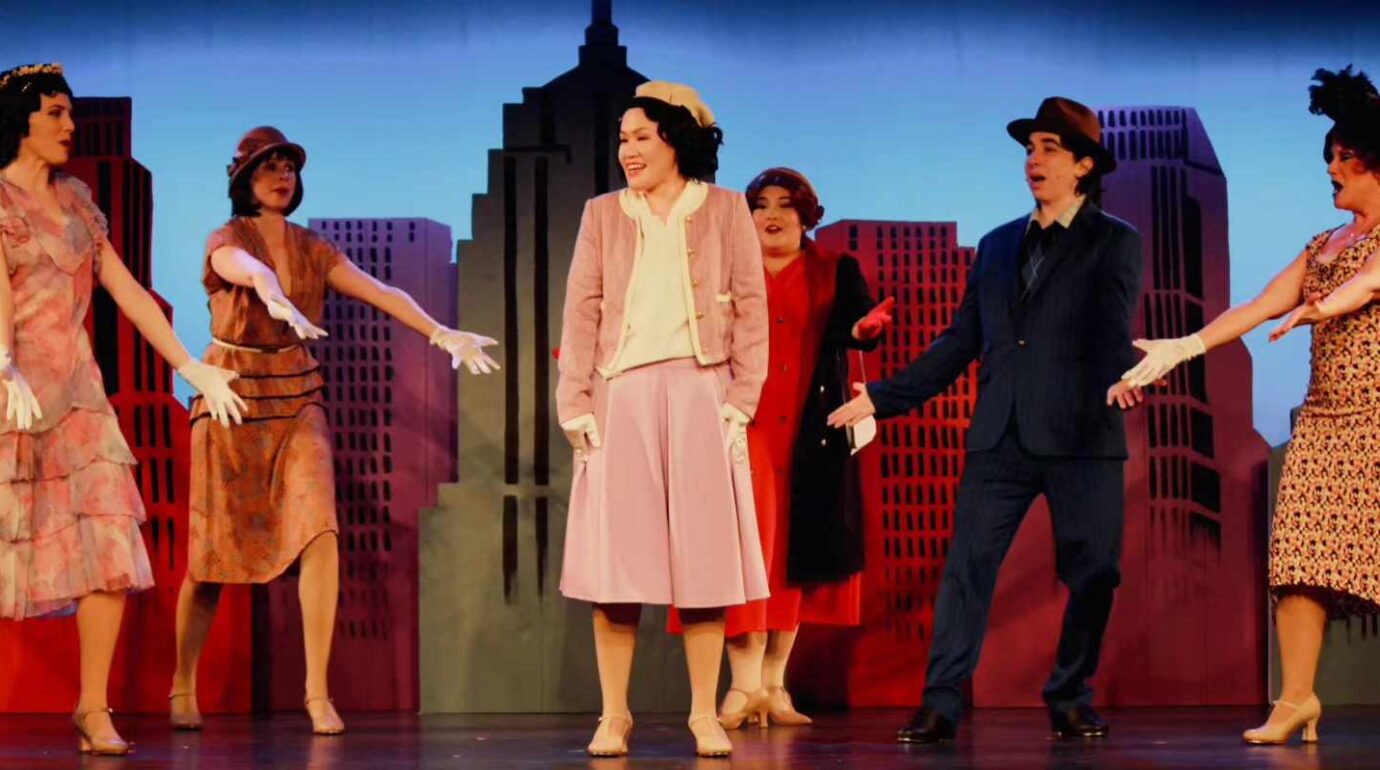Broadway dreams. We’ve all had ‘em. And Scottfield Theatre Company is havin’ ‘em right now. They’ve got all you need to cheer you up right on the ends of their ankles! Side by side— they’re glorified— that amazing tap corps that makes up the splashiest, flashiest dance routines of 42nd Street. Directed and Choreographed by Becky Titelman, with Musical Direction by LaShelle Bray, this iconic golden-era Broadway musical is a true dancer’s dream and every bit the spectacular dance show one expects.
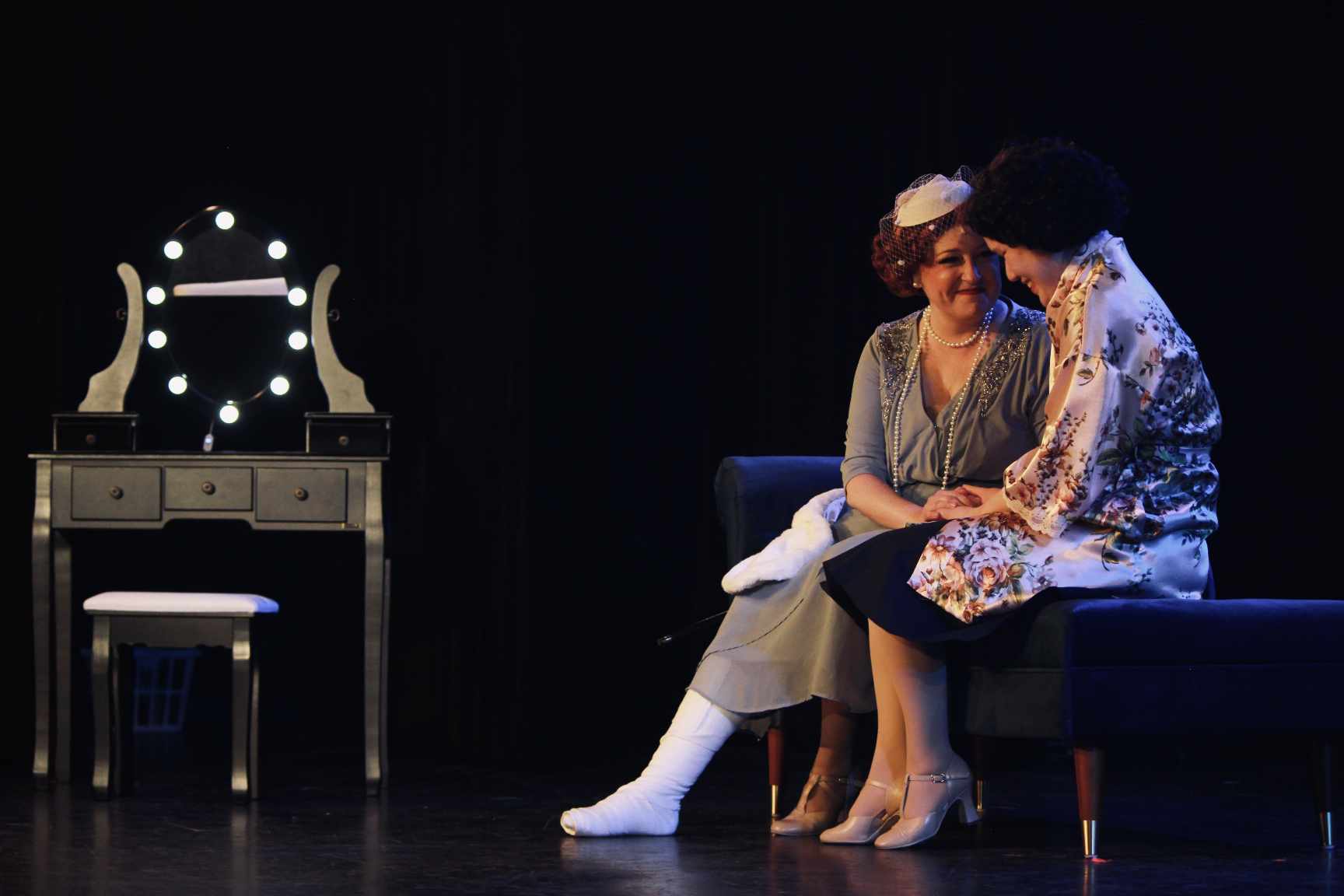
It’s a minimalist set— a blank scrim for holding those darling light cues, fabricated and flashed by Patrick Yarrington, and a few carefully constructed scenic pieces that drift in and out of play— and it’s effective. For as many grandiose tap routines featured in the production, the set cannot be bogged down with heavy pieces of scenery. The city skyline buildings (conceived by Ben Marsh and Becky Titelman) are crunched tightly together and bountifully so when they’re in New York City and are more sparse and evenly spaced when the show migrates to Philly. You get a lit dressing room vanity table and a chaise lounge, a garment-costume rack and a few other tables and chairs here and there but you don’t really need much more than that as the wondrous spectacle of all the superb dancing captivates and holds the attention of everyone in the audience for much of the performance.
Circling back to Yarrington’s lighting design; it’s both effective and eye-catching. There’s a gentle rainbow sweep, which aligns with a bigger vision of agency during “Dames” across the back scrim, and several uses of varying shades of blue which appropriately set the tone for whatever song is being sung in that moment. Yarrington’s masterpiece, however, is ‘murder red’, which splashes in perfect synchronicity with an intentional spin-drop incident during “Forty-Second Street” and you’ll find that this effect has your jaw dropping. The timing of the slow-motion spin, action, and drop, perfectly synched with that red lighting cue is truly stunning. You get a great deal of Yarrington’s colorful concoctions sprinkled appropriately throughout the performance and it elevates the overall mood of the show.
Color me impressed that Sound Designer Scott Harclerode keeps the mics and canned music perfectly balanced throughout the performance. It can sometimes be a crapshoot— like a one-way ticket from Allentown— as to whether or not you’re going to get good sound balance at the community level, but Harclerode manages an extremely well-blended one with this performance, which is a blessing as Musical Director LaShelle Bray’s talents can be more readily heard in all of her work she’d done with the singers of the production. You get sweeping swells of sound in the ensemble numbers, which really carry out into the house, fortifying the largess that is anticipated with a show like 42nd Street. It’s the smaller harmonies— like whenever she groups three or four fellas together in an almost barbershop quartet style or when the ‘named tap girls’ get to do blended harmonies during their features— that really land the show from a vocal standpoint. There are talented soloists all throughout the performance, but having that robust ensemble sound, in addition to those well-polished smaller group numbers really puts a Broadway shine on the production.
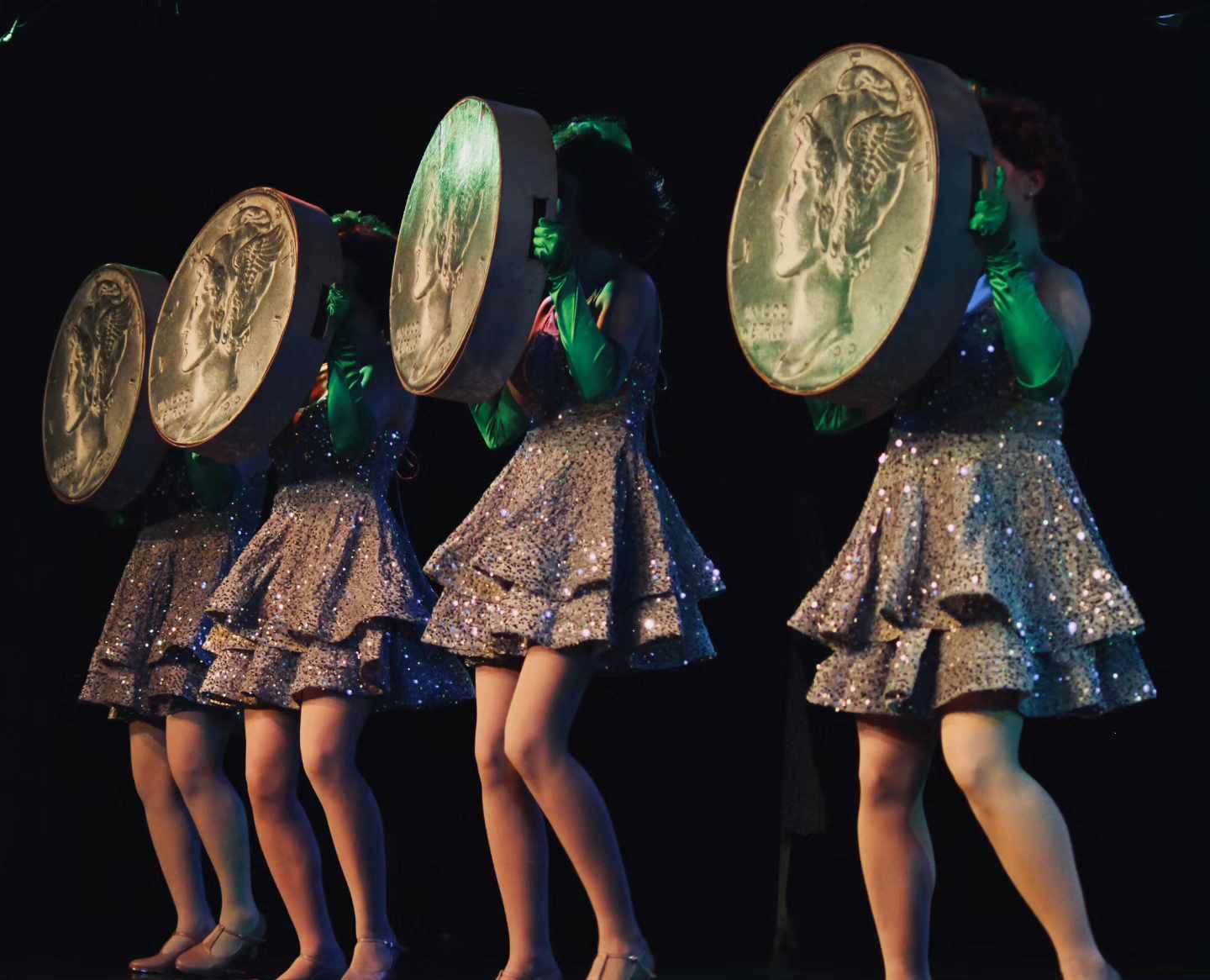
The production does not disappoint with all the glamour and glitz of the costumes either. Costume Designer Liz Marion has pulled out all the stops to get the flashiest, splashiest sartorial selection well situated on all of the performers and settled nicely into the era of the show. The tight-curl wigs on all the ladies are spot-on for the time period and the fashion featured in this production makes me want to go shopping. One of Marion’s finest achievements is the array of beautiful rainbow silk-style flow dresses that get fitted to each of the tap corps girls for the number “Dames.” Each of those girls look stunning as they strut out in various shades of red, orange, yellow, green, blue, and purple to create this dazzling rainbow effect when they stand in formation (against Yarrington’s rainbow backsplash lighting) with matching fascinators and gloves. It’s a subtle nod to acceptance and pride in a song that is otherwise quite degrading for women on the whole. Marion has more sequins and glitzy reflective costume pieces in this show than the ball in Times Square— the shimmery silver dresses for the tap corps during “We’re In The Money” and all of her own glamorous gorgeous gowns (as Marion also plays Dorothy Brock) are breathtakingly beautiful. The suits on the men are well-tailored and look as if they’ve been fitted to each individual performer (possibly with an assist from Seamstress Zonda Norwood) and the ‘rehearsal wear’ that you see on the various ensemble gals is just so chic and sporty and perfectly, perfectly accenting the times and the physique of every ‘kid’ on the line. I could gush on about the costumes but my descriptors aren’t really going to do them justice; they’re just sparkling wonders you’ll have to see for yourself in person when you come to 42nd Street.
Director Becky Titelman keeps the show moving at a clip. It’s hard to make these old-school-classics keep their pacing, but with Kalea Bray as the Stage Manager Titelman’s efforts are not for naught. Scenic transitions happen swiftly and smoothly— even though the set is of minimalist design, there are still pieces that have to get whipped on and off, most of which are choreographed to look as if they’re part of the act itself, which works well with the “show-within-a-show” concept that 42nd Street is constructed around. What is most impressive about Titelman’s direction here is the little moments she captures— the spin-drop that was previously described with flawless lighting near the end of the production, the absolutely jaw-dropping movement executed by Julian Marsh as the last visual of the performance when he slow-pulls the scarf at the end of “Act Two Finale: Forty-Second Street”, the way Peggy Sawyer slips the crowd scene and they all hop-turn in surprise to see her at the end of “Lullaby of Broadway”— it’s these little freeze-frame picturesque moments that enhance the show. The rainbow pan-fan of chorus girls during “Dames” (I’ve mentioned that two or three times now, so you know it must be impressive) and just the overall spatial placement of characters in scenes is what really puts Titelman’s mark on the show as a director.
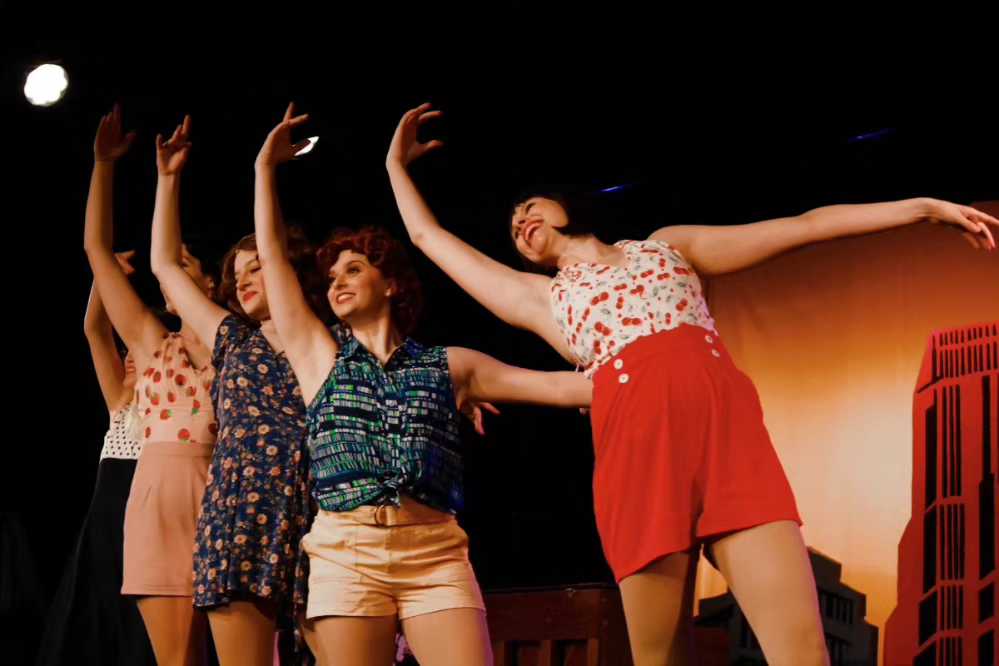
Everyone knows the line— come and meet, those dancing feet! And you will meet them in spades. Doubling up as the show’s choreographer, Becky Titelman has outdone herself with all of the phenomenal tap routines that get featured in frenetic perpetuality during this production. The whole show opens with this high-octane, military-crisp tap routine that has the audience screaming the heads off before you even dip your toe into the show! Titelman seems to have even taught the corps the tricky art of “walking on tap”, which is a skillset I love to see being utilized. All too often, when performers are in their tap shoes, especially for a ‘surprise tap number’ that comes busting out of nowhere, you hear them clunking onto the stage, clickity-clacking well before the number gets underway. Not with these performers; they’ve all been schooled in how to carefully move so as to minimize their tapping-toe-sounds before the dance gets started. Razzle, dazzle, splash, flash, and all of those astonishing things that come along with a superbly executed choreographic tap series are here in 42nd Street and it’s really something wild to watch.
All the praises are being sung to the Taps Corps— Laura Brown-Spencer, Katelyn Dixon, Gabby Harris, Sarah Harris, Samantha Jednorski, Laura May, Tate Menges, Sophia MacKinnon, and Hallie Moore, with Menges and Dixon taking up the lead roles of Billy and Peggy Sawyer, respectively. The effervescence and enthusiasm that this sensational bunch possesses whenever they roll into those tap routines is nothing short of phenomenal. They’re always smiling, have exacting timing, flawless execution, and make you feel like you’re watching a professional-grade Rockettes kind of show. “We’re In The Money”, “Montage”, “Forty-Second Street”, really any chance Titelman has to throw tap into the show, she’s done it and these nine performers have gone above and beyond to deliver. You get even more dancing and singing from Laura May, Samantha Jednorski, Laura Brown-Spencer, and Gabby Harris (as ‘Anytime Annie’, Phyllis, Lorraine, and Gladys, respectively…occasionally referred to as ‘the named kids in the line.’) This little quartet of fire-cracking tappers not only have all the ferocious zest of tapping and dancing their way through every vivacious moment of production, but they’re also bringing that trans-Atlantic New York patois and cadence to their speaking voices (which is something this show is otherwise lacking from all of the other New York characters) and it’s refreshing to hear that level of character work to come into play with their characters. The praises of the dancing and the tap corps for this production cannot be sung highly enough. They are the glimmering, gleaming glue that holds this show together and they are truly what makes this show well worth seeing.
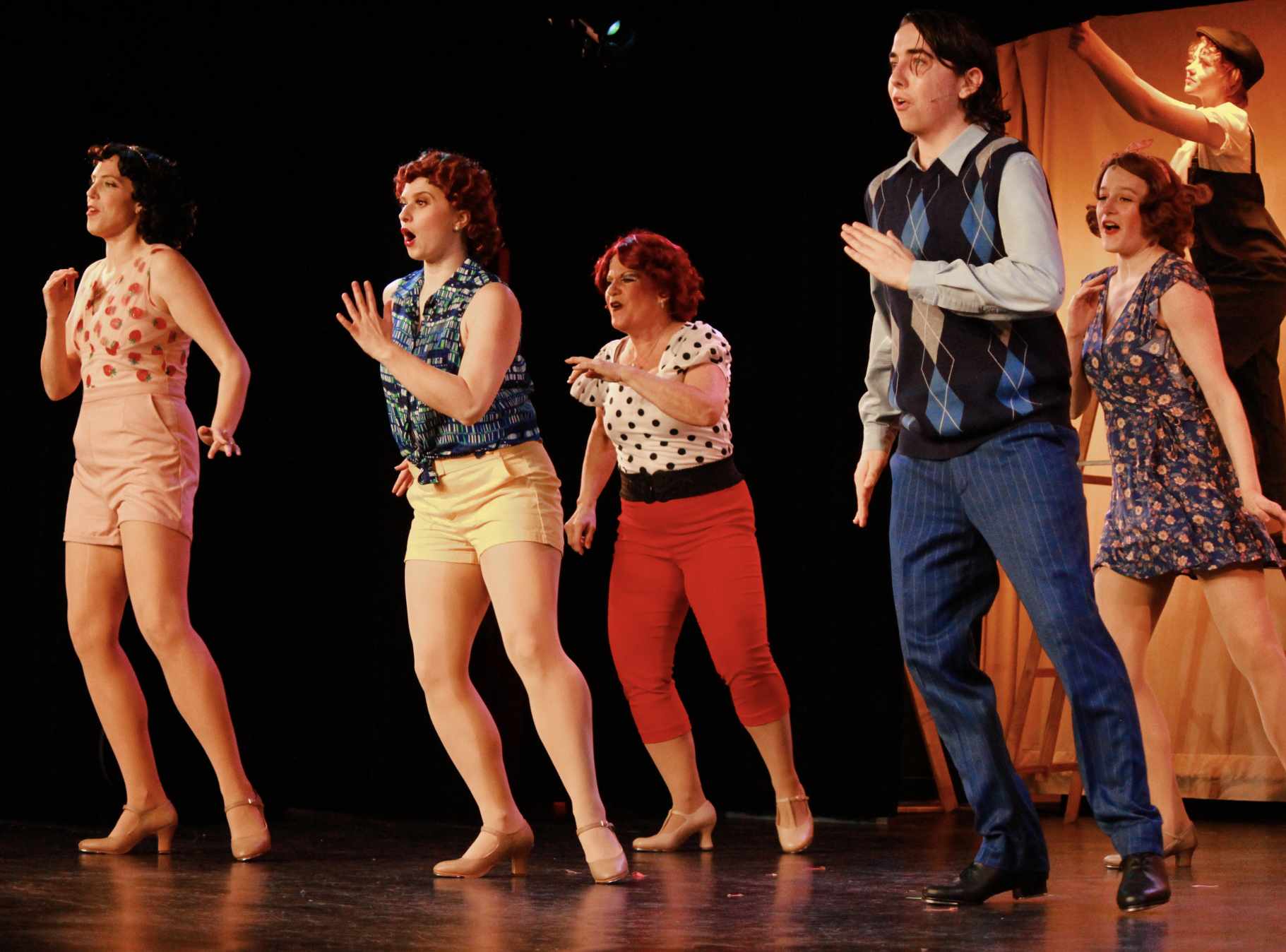
There’s a minor chemistry hiccup in the men’s department of the show and while it doesn’t wholly derail the performance, it’s noticeable enough that it bares mentioning. Often times in community theatre, casting is beholden to “who turns up to auditions” and that’s just life in theatre culture. Both of the ‘lead/supporting’ male roles— Julian Marsh (Anthony Case) and Pat Denning (Chris Barsam)— unfortunately fall flat in regards to their overall existence and general chemistry with the women in the story with whom they interact. For Barsam’s Pat Denning, it’s somewhat less noticeable and more forgivable as he only has a few stolen moments with Dorothy Brock, but the desperate need to be her secret lover and to make that engaging connection is just not there on his end.
As for Case in the role of Julian Marsh, it’s just somewhat of a mixed bag. While Case really bowls the audience over when he barrel-blasts his way into “Lullaby of Broadway” and again when he finishes with this tremendously powerful belt in “Act Two Finale: Forty-Second Street,” these are the only moments where you feel like you’re getting a real sense of Julian Marsh the way he’s written. Case ends up delivering the character without the toxic machismo, ball-busting-brass, or any of the fury and cocky confidence that comes with the character’s pedigree. The subtler, softer approach that Case is taking with the character doesn’t give Julian Marsh the drive that both makes the “kids in the line” afraid of him or the overall determination to really raise the stakes when he and the company have to go fetch Peggy Sawyer from the train station. Chalk it up to opening night jitters or just a general sense of being uncertain of how to make a stage kiss read well, but the whole ‘kiss-n-crush’ scene with the Peggy Sawyer character just read as awkward, which is another shame as this is such a pinnacle moment in the show. There were also some dropped/fumbled lines early in the evening, but again, quite possibly a case of opening night jitters. It’s like watching two completely different characters on stage with Case’s Julian Marsh; the singing Julian which is exactly how Julian Marsh is supposed to sound and really wins the audience over, resulting in thunderous ovations, and the acting Julian, which leaves the audience feeling somewhat confused and questioning.
Those chemistry issues aside, Scottfield Theatre Company has pulled together a strong ensemble (Lauren Beward, Michelle Hosier, Hanna Lyons, Adam Nelson, Sam Ranocchia, Chris Williams, and Sara Ulrich) to fill out the stage. You can often catch Lauren Beward and Adam Nelson, as “Olive & Mac” hauling the rehearsal piano in and out of scenes for the meta-show-within-a-show of Pretty Ladies and their bits, though silent are wildly entertaining. Nelson also gets doubled-dipped as the ‘doctor’ at the very top of Act II and although he has less than 15 seconds of speaking, he adapts a thick Scotch-Irish brogue that was so sturdy it felt worthy of a mention. Sam Ranocchia is also the cowboy-kiddie-car-peddler, Abner Dillon, and his fringe jacket is really something.
You get some chuckles and laughs from the “character cads” of Maggie Jones (Meg Smith) and Bert Barry (JJ Devoe) and they both have voices that are well suited for the musical style of the performance. Devoe in particular has a fun series of chaos with Anytime Annie (Laura May, who is not only a ‘named line kid’ but doubles up as the show’s dance captain) during “Shuffle Off to Buffalo.” You can watch their antics, as well as his antics with all the rest of the ‘chorus girls’ and it’ll just tickle you silly with laughter.
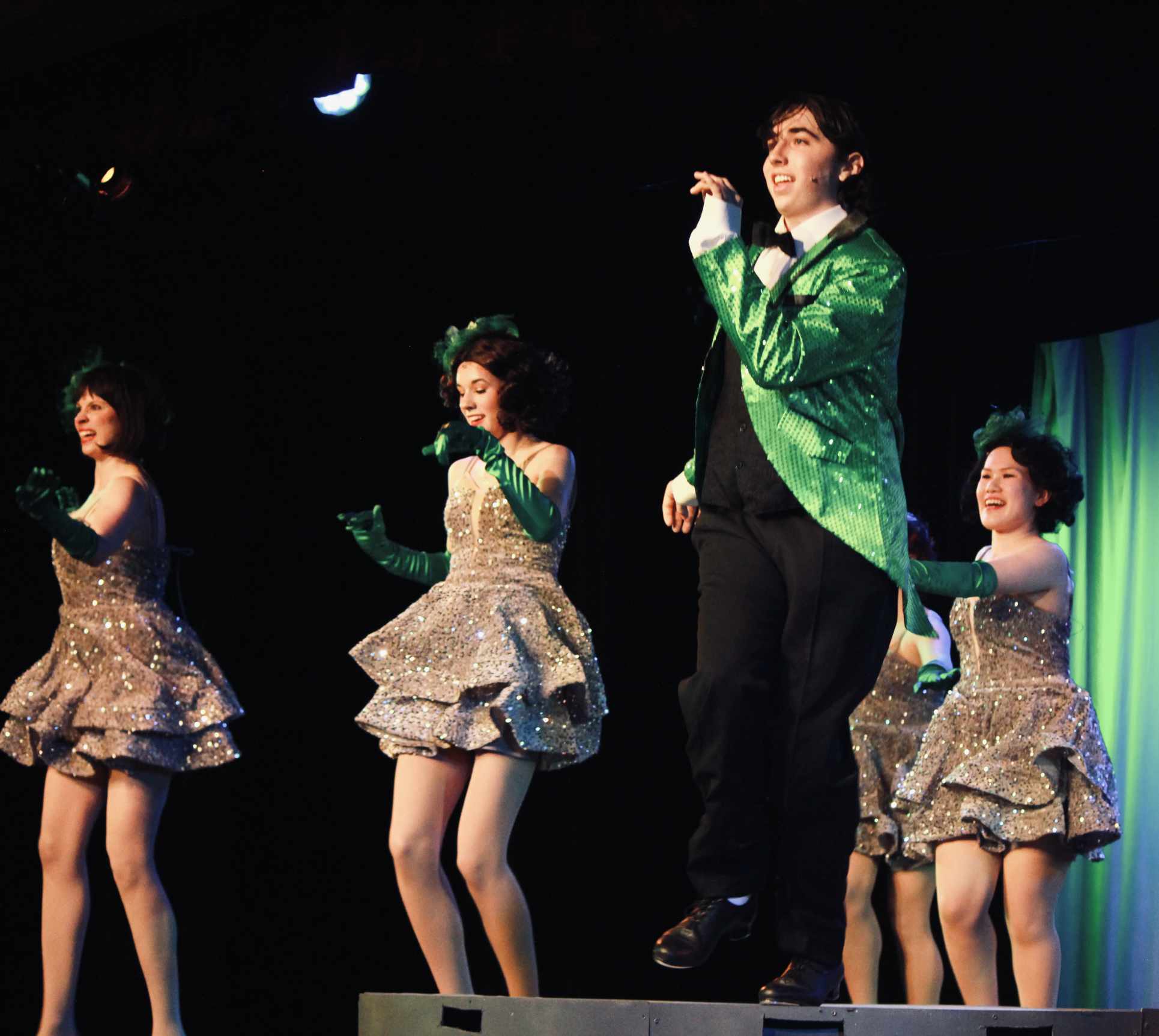
Tate Menges is living up to the vibrant, youthful expectations of the ‘dance-line ingenue’ in his role of Billy Lawlor. Though his singing is just the tiniest bit pitchy (particularly in his opening bid “Young and Healthy” with Peggy) he’s got fantastic energy, a sweet sincerity and overall disposition and this kid can dance circles around almost anyone else on the stage— and that’s saying something considering how very talented the rest of the tap corps is! He gets the ‘dance-lead’ in several of the tap numbers, including “We’re In The Money” and the ‘dance-chase’ duet with Peggy Sawyer during “Forty-Second Street” and you won’t be able to take your eyes off of him for all the sensational skill he’s serving up. Menges’ voice blends really beautifully when he’s singing his bits during “Lullaby of Broadway”, and it’s in that number where you get some of that glorious ‘barbershop quartet’ style harmony building with Menges, Chris Williams as Andy (the other stage-hand-style-assistant to Mr. Marsh), Devoe as Bert, and Case as Marsh.
The dueling divas— the debonaire delights— the dashing darlings of the stage— Dorothy Brock (Liz Marion) and Peggy Sawyer (Katelyn Dixon.) While the pair don’t actually spend much time interacting…at least not pleasantly, as it’s often Dorothy Brock biting Peggy Sawyer’s head off as divas are wont to do… you do get this lovely, dynamic, semi-duet late in the second act in the dressing room between Marion and Dixon— “About a Quarter to Nine.” While the song itself it short-lived, it’s delectable to hear Dixon and Marion’s voices blending so beautifully together in that one moment of unity.
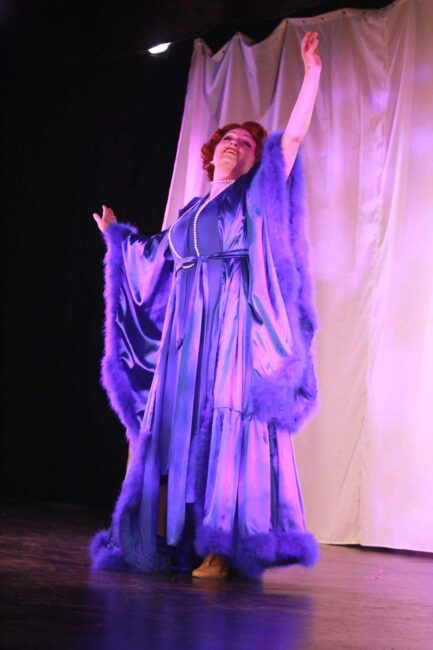
As the stage diva Dorothy Brock, Liz Marion settles into the role superbly, if at first on her more signature comedic footing. There’s a little bit of that Vaudeville chaos in her portrayal, particularly in the earlier scenes and while that’s not how the more traditional Dorothy Brocks are presented, Marion makes that work to her advantage. Ds And it’s wondrously beautiful to here that contralto voice of hers, all lounge-lizard-smooth rolling through “Act One Finale: Forty-Second Street.” Marion delivers vocal smolder at its finest in that moment. What’s really impressive about Marion’s approach to the character is the moment that she humanizes Dorothy Brock for the audience. The curtain closes, Marion moves to the side-lip of the apron, and all eyes on her as she bleeds her heart into “I Only Have Eyes For You.” It’s this stunning moment of desperate, boy-crazy, heart-broken, vulnerability that reads with such a raw punch of intensity that you’re just awestruck. Truly a phenomenal sensation in making this role work for her rather than having to make herself work the role, Liz Marion puts an exacting balance in her portrayal of Dorothy Brock, making her both iconic and her own all at once.
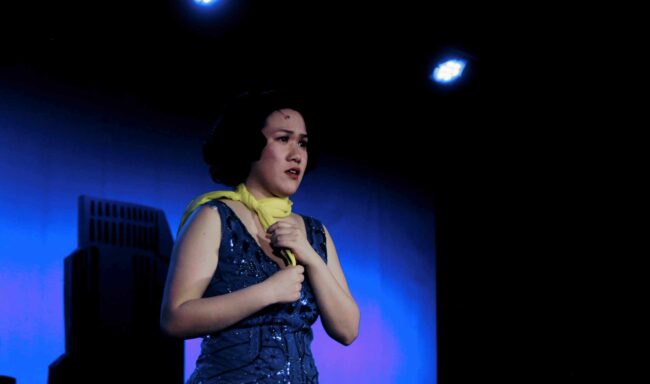
As for Katelyn Dixon in the role of Peggy Sawyer, she’s carrying the epitaph of youth, beauty, and freshness in her performance. In addition to phenomenal tap skills and powerhouse singing. Dixon masterfully delivers the epitome of dewy-eyed gooey-hearted, fresh-faced ingenue girl who takes a while to fall into her stride. Getting to watch Dixon grow the character from Allentown’s nervous Nellie into a proper shimmering Broadway star is truly spectacular. And as Marsh says, “She’s a hoofer.” She can tap, spin, flick, kick, and twirl with the best of them, there’s no denying that. Dixon has that irrepressible giddiness about her, even when her character is nervous, it just manifests differently in those moments of doubt, but you never lose the sense of wonder and jittery glee that she brings to this character, even in her moments of stillness. You get glorious sounds from Dixon every time she sings, particularly when you finally get to hear her take on “Forty-Second Street” during the penultimate number of the show. She’s completely impressive in the role and you can’t take your eyes off of her when she’s blossoming her way out of the ensemble and into the limelight.
It’s the avenue they’re taking you to— well, it’s technically a street, Union Street in historic Havre de Grace, because that’s where the Opera House is— but it’s naughty, gaudy, bawdy, sporty— 42nd Street. Don’t miss your chance to see these phenomenal tap dancers, two stellar leading ladies, and one big splashy show with tap-routines and costumes that’ll knock your socks off. Catch 42nd Street before it taps away next weekend.
42nd Street plays through April 21st 2024 with Scottfield Theatre Company currently in residence at the Cultural Center at The Havre de Grace Opera House— 121 N. Union Street in historic downtown Havre de Grace, MD. For tickets call the box office at 667-225-8433 or purchase them online.
To read the interview with Katelyn Dixon on playing Peggy Sawyer, click here.
To read the interview with Liz Marion on playing Dorothy Brock, click here.

